Can Economic Growth and Environmental Protection Achieve a “Win–Win” Situation? Empirical Evidence from China
Abstract
:1. Introduction
2. Literature Review
3. Methods
- Step 1. Indicator selection and data acquisition.
- Step 2. Indicator processing and aggregation.
- Step 3. Estimated values of EG and EPI over time and decoupling analysis.
- i.
- Decoupling (D). The first major category is the decoupling state, which contains three subcategories and usually refers to a situation where the environmental pressure is rising lower than economic growth. This indicates that the dependence of economic growth on environmental damage as well as resource consumption are weakening. Weak decoupling (WD) indicates that both are increasing, but that economic growth is significantly faster than environmental pressure. Recessive decoupling (RD) indicates that both are decreasing, but environmental pressure is decreasing faster, and strong decoupling (SD) indicates that environmental pressure is decreasing while the economy is growing. Therefore, in this paper, we define the SD state as the “win–win” state between the EG and EPI.
- ii.
- Coupling (C). The second major category is the coupling state, which contains two subcategories and usually refers to the fact that the changes in environmental pressure and economic performance show almost the same rate of change. This indicates a strong dependence between economic development and environmental damage. In this case, recessive coupling (RC) indicates that both fall at similar rates and expansive coupling (EC) indicates that both rise at similar rates.
- iii.
- Negative decoupling (ND). The third major category is the negative coupling state, which contains three subcategories and usually refers to a situation where environmental pressure is significantly greater than economic growth, which is a completely unsustainable state. Among them, expansive negative decoupling (END) indicates that both are increasing with a more pronounced rise in environmental pressure, strong negative decoupling (SND) indicates an increase in environmental pressure and an economic recession, and weak negative decoupling (WND) indicates that both are decreasing, but with a more pronounced economic recession.
4. Results and Analysis
4.1. Results of Decoupling Status between Economic Growth and Environmental Pressures at the National and Provincial Levels
4.2. Analysis of the Temporal Evolution of the Decoupling between Environmental Pressure and Economic Performance
4.2.1. Decoupling between Environmental Pressure and Economic Performance at the National Level
4.2.2. Decoupling between Environmental Pressure and Economic Performance at the Provincial level
4.3. Analysis on the Spatial Differences of the Decoupling between Environmental Pressure and Economic Performance
5. Discussion
6. Conclusions
Author Contributions
Funding
Institutional Review Board Statement
Informed Consent Statement
Data Availability Statement
Conflicts of Interest
References
- Zhang, X.; Geng, Y.; Shao, S.; Song, X.; Fan, M.; Yang, L.; Song, J. Decoupling PM2.5 emissions and economic growth in China over 1998–2016: A regional investment perspective. Sci. Total Environ. 2020, 714, 136841. [Google Scholar] [CrossRef] [PubMed]
- Li, B.; Gasser, T.; Ciais, P.; Piao, S.; Tao, S.; Balkanski, Y.; Hauglustaine, D.; Boisier, J.-P.; Chen, Z.; Huang, M. The contribution of China’s emissions to global climate forcing. Nature 2016, 531, 357–361. [Google Scholar] [CrossRef] [PubMed]
- Liang, Q.-M.; Deng, H.-M.; Liu, M. Co-control of CO2 emissions and local pollutants in China: The perspective of adjusting final use behaviors. J. Clean. Prod. 2016, 131, 198–208. [Google Scholar] [CrossRef]
- Liu, G.; Yang, Z.; Fath, B.D.; Shi, L.; Ulgiati, S. Time and space model of urban pollution migration: Economy-energy-environment nexus network. Appl. Energy 2017, 186, 96–114. [Google Scholar] [CrossRef] [Green Version]
- Chen, B.; Song, Y.; Jiang, T.; Chen, Z.; Huang, B.; Xu, B. Real-time estimation of population exposure to PM2.5 using mobile-and station-based big data. Int. J. Environ. Res. Public Health 2018, 15, 573. [Google Scholar] [CrossRef] [PubMed] [Green Version]
- Chen, B.; Song, Y.; Kwan, M.-P.; Huang, B.; Xu, B. How do people in different places experience different levels of air pollution? Using worldwide Chinese as a lens. Environ. Pollut. 2018, 238, 874–883. [Google Scholar] [CrossRef]
- Song, Y.; Huang, B.; He, Q.; Chen, B.; Wei, J.; Mahmood, R. Dynamic assessment of PM2.5 exposure and health risk using remote sensing and geo-spatial big data. Environ. Pollut. 2019, 253, 288–296. [Google Scholar] [CrossRef]
- He, Q.; Zhang, M.; Song, Y.; Huang, B. Spatiotemporal assessment of PM2.5 concentrations and exposure in China from 2013 to 2017 using satellite-derived data. J. Clean. Prod. 2021, 286, 124965. [Google Scholar] [CrossRef]
- Lu, Y.; Zhang, Y.; Cao, X.; Wang, C.; Wang, Y.; Zhang, M.; Ferrier, R.C.; Jenkins, A.; Yuan, J.; Bailey, M.J. Forty years of reform and opening up: China’s progress toward a sustainable path. Sci. Adv. 2019, 5, eaau9413. [Google Scholar] [CrossRef] [Green Version]
- Siping, J.; Wendai, L.; Liu, M.; Xiangjun, Y.; Hongjuan, Y.; Yongming, C.; Haiyun, C.; Hayat, T.; Alsaedi, A.; Ahmad, B. Decoupling environmental pressures from economic growth based on emissions monetization: Case in Yunnan, China. J. Clean. Prod. 2019, 208, 1563–1576. [Google Scholar] [CrossRef]
- Shi, Y.B.; Zhao, X.X.; Jang, C.-L.; Chang, C.-P. Decoupling effect between economic development and environmental pollution: A spatial-temporal investigation using 31 provinces in China. Energy Environ. 2019, 30, 755–775. [Google Scholar] [CrossRef]
- Hao, Y.; Wu, Y.; Wang, L.; Huang, J. Re-examine environmental Kuznets curve in China: Spatial estimations using environmental quality index. Sustain. Cities Soc. 2018, 42, 498–511. [Google Scholar] [CrossRef]
- Li, X.; Wu, X.; Zhang, F. A method for analyzing pollution control policies: Application to SO2 emissions in China. Energy Econ. 2015, 49, 451–459. [Google Scholar] [CrossRef]
- Liu, W.; Liu, T. Exploring the Impact and Path of Environmental Protection Tax on Different Air Pollutant Emissions. Int. J. Environ. Res. Public Health 2022, 19, 4767. [Google Scholar] [CrossRef] [PubMed]
- Young, O.R.; Guttman, D.; Qi, Y.; Bachus, K.; Belis, D.; Cheng, H.; Lin, A.; Schreifels, J.; Van Eynde, S.; Wang, Y. Institutionalized governance processes: Comparing environmental problem solving in China and the United States. Glob. Environ. Chang. 2015, 31, 163–173. [Google Scholar] [CrossRef]
- Zheng, D.; Shi, M. Multiple environmental policies and pollution haven hypothesis: Evidence from China’s polluting industries. J. Clean. Prod. 2017, 141, 295–304. [Google Scholar] [CrossRef]
- Du, X.; Shen, L.; Wong, S.W.; Meng, C.; Yang, Z. Night-time light data based decoupling relationship analysis between economic growth and carbon emission in 289 Chinese cities. Sustain. Cities Soc. 2021, 73, 103119. [Google Scholar] [CrossRef]
- Ji, Y.; Xue, J. Decoupling Effect of County Carbon Emissions and Economic Growth in China: Empirical Evidence from Jiangsu Province. Int. J. Environ. Res. Public Health 2022, 19, 3275. [Google Scholar] [CrossRef]
- Wu, Y.; Tam, V.W.; Shuai, C.; Shen, L.; Zhang, Y.; Liao, S. Decoupling China’s economic growth from carbon emissions: Empirical studies from 30 Chinese provinces (2001–2015). Sci. Total Environ. 2019, 656, 576–588. [Google Scholar] [CrossRef]
- Huang, J.; Shen, J.; Miao, L. Carbon emissions trading and sustainable development in China: Empirical analysis based on the coupling coordination degree model. Int. J. Environ. Res. Public Health 2021, 18, 89. [Google Scholar] [CrossRef]
- Miao, L. Examining the impact factors of urban residential energy consumption and CO2 emissions in China—Evidence from city-level data. Ecol. Indic. 2017, 73, 29–37. [Google Scholar] [CrossRef]
- Smil, V. China’s Environmental Crisis: An Enquiry into the Limits of National Development; Routledge: London, UK, 2016. [Google Scholar]
- Cao, W.; Zhang, Y.; Qian, P. The effect of innovation-driven strategy on green economic development in China—An empirical study of smart cities. Int. J. Environ. Res. Public Health 2019, 16, 1520. [Google Scholar] [CrossRef] [PubMed] [Green Version]
- Wang, M.; Feng, C. The win-win ability of environmental protection and economic development during China’s transition. Technol. Forecast. Soc. Chang. 2021, 166, 120617. [Google Scholar] [CrossRef]
- das Neves Almeida, T.A.; Cruz, L.; Barata, E.; García-Sánchez, I.-M. Economic growth and environmental impacts: An analysis based on a composite index of environmental damage. Ecol. Indic. 2017, 76, 119–130. [Google Scholar] [CrossRef]
- Zeraibi, A.; Balsalobre-Lorente, D.; Shehzad, K. Testing the environmental Kuznets curve hypotheses in Chinese provinces: A nexus between regional government expenditures and environmental quality. Int. J. Environ. Res. Public Health 2021, 18, 9667. [Google Scholar] [CrossRef]
- Song, W.; Ye, C.; Liu, Y.; Cheng, W. Do China’s Urban–Environmental Quality and Economic Growth Conform to the Environmental Kuznets Curve? Int. J. Environ. Res. Public Health 2021, 18, 13420. [Google Scholar] [CrossRef]
- Madaleno, M.; Moutinho, V. Analysis of the new kuznets relationship: Considering emissions of carbon, methanol, and nitrous oxide greenhouse gases—Evidence from EU countries. Int. J. Environ. Res. Public Health 2021, 18, 2907. [Google Scholar] [CrossRef]
- Adebayo, T.S.; Agboola, M.O.; Rjoub, H.; Adeshola, I.; Agyekum, E.B.; Kumar, N.M. Linking economic growth, urbanization, and environmental degradation in China: What is the role of hydroelectricity consumption? Int. J. Environ. Res. Public Health 2021, 18, 6975. [Google Scholar] [CrossRef]
- Mukherjee, S.; Chakraborty, D. Is environmental sustainability influenced by socioeconomic and sociopolitical factors? Cross-country empirical evidence. Sustain. Dev. 2013, 21, 353–371. [Google Scholar] [CrossRef]
- Ahmed, K.; Long, W. Environmental Kuznets curve and Pakistan: An empirical analysis. Procedia Econ. Financ. 2012, 1, 4–13. [Google Scholar] [CrossRef] [Green Version]
- Lopez, R.; Mitra, S. Corruption, pollution, and the Kuznets environment curve. J. Environ. Econ. Manag. 2000, 40, 137–150. [Google Scholar] [CrossRef] [Green Version]
- Grossman, G.M.; Krueger, A.B. Environmental Impacts of a North American Free Trade Agreement; National Bureau of Economic Research: Cambridge, MA, USA, 1991. [Google Scholar] [CrossRef]
- Zhao, F.; Xu, M.; Zheng, Y.; Wong, M.H.G.; Chi, Y. Improving the environmental Kuznets curve for evaluating the relationships between carbon dioxide emissions and economic development. J. Food Agric. Environ. 2013, 11, 1193–1199. [Google Scholar]
- Kang, Y.-Q.; Zhao, T.; Yang, Y.-Y. Environmental Kuznets curve for CO2 emissions in China: A spatial panel data approach. Ecol. Indic. 2016, 63, 231–239. [Google Scholar] [CrossRef]
- Lee, Y.; Mukherjee, D. New nonparametric estimation of the marginal effects in fixed-effects panel models: An application on the environmental Kuznets curve. SSRN Electron. J. 2008. [Google Scholar] [CrossRef]
- Steger, T.M.; Egli, H. A dynamic model of the environmental Kuznets curve: Turning point and public policy. In Sustainable Resource Use and Economic Dynamics; Springer: Cham, Switzerland, 2007; pp. 17–34. [Google Scholar]
- Zaim, O.; Taskin, F. Environmental efficiency in carbon dioxide emissions in the OECD: A non-parametric approach. J. Environ. Manag. 2000, 58, 95–107. [Google Scholar] [CrossRef]
- Zhu, P.; Yuan, J.; Zeng, W. Analysis of Chinese Industry Environmental Kuznets Curve—Empirical Study Based on Spatial Panel Model. China Ind. Econ. 2010, 6, 65–74. [Google Scholar]
- Cleveland, C.J.; Stern, D.I.; Costanza, R. The Economics of Nature and the Nature of Economics; Edward Elgar Publishing: Cheltenham, UK, 2001. [Google Scholar]
- Brajer, V.; Mead, R.W.; Xiao, F. Searching for an Environmental Kuznets Curve in China’s air pollution. China Econ. Rev. 2011, 22, 383–397. [Google Scholar] [CrossRef]
- Tevie, J.; Grimsrud, K.M.; Berrens, R.P. Testing the environmental Kuznets curve hypothesis for biodiversity risk in the US: A spatial econometric approach. Sustainability 2011, 3, 2182–2199. [Google Scholar] [CrossRef] [Green Version]
- Hao, Y.; Liu, Y.-M. The influential factors of urban PM2.5 concentrations in China: A spatial econometric analysis. J. Clean. Prod. 2016, 112, 1443–1453. [Google Scholar] [CrossRef]
- Al-Mulali, U.; Ozturk, I.; Solarin, S.A. Investigating the environmental Kuznets curve hypothesis in seven regions: The role of renewable energy. Ecol. Indic. 2016, 67, 267–282. [Google Scholar] [CrossRef]
- Dasgupta, S.; Hettige, H.; Wheeler, D. What improves environmental compliance? Evidence from Mexican industry. J. Environ. Econ. Manag. 2000, 39, 39–66. [Google Scholar] [CrossRef]
- Ozturk, I.; Al-Mulali, U. Investigating the validity of the environmental Kuznets curve hypothesis in Cambodia. Ecol. Indic. 2015, 57, 324–330. [Google Scholar] [CrossRef]
- Perman, R.; Stern, D.I. Evidence from panel unit root and cointegration tests that the environmental Kuznets curve does not exist. Aust. J. Agric. Resour. Econ. 2003, 47, 325–347. [Google Scholar] [CrossRef] [Green Version]
- Wang, Y.; Kang, L.; Wu, X.; Xiao, Y. Estimating the environmental Kuznets curve for ecological footprint at the global level: A spatial econometric approach. Ecol. Indic. 2013, 34, 15–21. [Google Scholar] [CrossRef]
- Stern, D.I.; Common, M.S. Is there an environmental Kuznets curve for sulfur? J. Environ. Econ. Manag. 2001, 41, 162–178. [Google Scholar] [CrossRef] [Green Version]
- Azomahou, T.; Laisney, F.; Van, P.N. Economic development and CO2 emissions: A nonparametric panel approach. J. Public Econ. 2006, 90, 1347–1363. [Google Scholar] [CrossRef] [Green Version]
- Jaunky, V.C. The CO2 emissions-income nexus: Evidence from rich countries. Energy Policy 2011, 39, 1228–1240. [Google Scholar] [CrossRef]
- Bertinelli, L.; Strobl, E. The environmental Kuznets curve semi-parametrically revisited. Econ. Lett. 2005, 88, 350–357. [Google Scholar] [CrossRef]
- Ahmed, K.; Rehman, M.U.; Ozturk, I. What drives carbon dioxide emissions in the long-run? Evidence from selected South Asian Countries. Renew. Sustain. Energy Rev. 2017, 70, 1142–1153. [Google Scholar] [CrossRef] [Green Version]
- Soytas, U.; Sari, R.; Ewing, B.T. Energy consumption, income, and carbon emissions in the United States. Ecol. Econ. 2007, 62, 482–489. [Google Scholar] [CrossRef]
- Roinioti, A.; Koroneos, C. The decomposition of CO2 emissions from energy use in Greece before and during the economic crisis and their decoupling from economic growth. Renew. Sustain. Energy Rev. 2017, 76, 448–459. [Google Scholar] [CrossRef]
- Mikayilov, J.I.; Hasanov, F.J.; Galeotti, M. Decoupling of CO2 emissions and GDP: A time-varying cointegration approach. Ecol. Indic. 2018, 95, 615–628. [Google Scholar] [CrossRef]
- Tarabusi, E.C.; Guarini, G. An axiomatic approach to decoupling indicators for green growth. Ecol. Indic. 2018, 84, 515–524. [Google Scholar] [CrossRef]
- Kong, Y.; He, W.; Yuan, L.; Zhang, Z.; Gao, X.; Degefu, D.M. Decoupling economic growth from water consumption in the Yangtze River Economic Belt, China. Ecol. Indic. 2021, 123, 107344. [Google Scholar] [CrossRef]
- Zhang, Y.; Sun, M.; Yang, R.; Li, X.; Zhang, L.; Li, M. Decoupling water environment pressures from economic growth in the Yangtze River Economic Belt, China. Ecol. Indic. 2021, 122, 107314. [Google Scholar] [CrossRef]
- OECD. Indicators to Measure Decoupling of Environmental Pressure From Economic Growth. In Sustainable Development; OECD: Paris, France, 2002. [Google Scholar]
- Song, Y.; Zhang, M.; Zhou, M. Study on the decoupling relationship between CO2 emissions and economic development based on two-dimensional decoupling theory: A case between China and the United States. Ecol. Indic. 2019, 102, 230–236. [Google Scholar] [CrossRef]
- Shan, Y.; Fang, S.; Cai, B.; Zhou, Y.; Li, D.; Feng, K.; Hubacek, K. Chinese cities exhibit varying degrees of decoupling of economic growth and CO2 emissions between 2005 and 2015. One Earth 2021, 4, 124–134. [Google Scholar] [CrossRef]
- Wang, Y.; Shi, L.; Chen, D.; Tan, X. Spatial-Temporal Analysis and Driving Factors Decomposition of (De) Coupling Condition of SO2 Emissions in China. Int. J. Environ. Res. Public Health 2020, 17, 6725. [Google Scholar] [CrossRef]
- Chow, G. Are Chinese official statistics reliable? CESifo Econ. Stud. 2006, 52, 396–414. [Google Scholar] [CrossRef]
- Shi, K.; Yu, B.; Huang, Y.; Hu, Y.; Yin, B.; Chen, Z.; Chen, L.; Wu, J. Evaluating the ability of NPP-VIIRS nighttime light data to estimate the gross domestic product and the electric power consumption of China at multiple scales: A comparison with DMSP-OLS data. Remote Sens. 2014, 6, 1705–1724. [Google Scholar] [CrossRef] [Green Version]
- Elvidge, C.D.; Safran, J.; Tuttle, B.; Sutton, P.; Cinzano, P.; Pettit, D.; Arvesen, J.; Small, C. Potential for global mapping of development via a nightsat mission. GeoJournal 2007, 69, 45–53. [Google Scholar] [CrossRef]
- Doll, C.N.; Muller, J.-P.; Morley, J.G. Mapping regional economic activity from night-time light satellite imagery. Ecol. Econ. 2006, 57, 75–92. [Google Scholar] [CrossRef]
- Qin, M.; Liu, X.; Li, S. How does urban sprawl affect regional economic growth?—A study based on night light data. China Econ. Q. 2019, 18, 527–550. [Google Scholar]
- Wang, Z.; Li, M.; Jiang, J. Effects of improving traffic accessibility on urban economic growth: Spatial econometric analysis based on DMSP/OLS nighttime satellite light data in 283 cities. China Econ. Probl. 2020, 5, 84–97. [Google Scholar]
- Ge, X.; Zhou, Z.; Zhou, Y.; Ye, X.; Liu, S. A spatial panel data analysis of economic growth, urbanization, and NOx emissions in China. Int. J. Environ. Res. Public Health 2018, 15, 725. [Google Scholar] [CrossRef] [PubMed] [Green Version]
- Abdul Jabbar, S.; Tul Qadar, L.; Ghafoor, S.; Rasheed, L.; Sarfraz, Z.; Sarfraz, A.; Sarfraz, M.; Felix, M.; Cherrez-Ojeda, I. Air Quality, Pollution and Sustainability Trends in South Asia: A Population-Based Study. Int. J. Environ. Res. Public Health 2022, 19, 7534. [Google Scholar] [CrossRef] [PubMed]
- Constantin, D.-E.; Bocăneala, C.; Voiculescu, M.; Roşu, A.; Merlaud, A.; Roozendael, M.V.; Georgescu, P.L. Evolution of SO2 and NOx emissions from several large combustion plants in europe during 2005–2015. Int. J. Environ. Res. Public Health 2020, 17, 3630. [Google Scholar] [CrossRef] [PubMed]
- Mozumder, P.; Berrens, R.P.; Bohara, A.K. Is there an environmental Kuznets curve for the risk of biodiversity loss? J. Dev. Areas 2006, 39, 175–190. [Google Scholar]
- Boutaud, A.; Gondran, N.; Brodhag, C. (Local) environmental quality versus (global) ecological carrying capacity: What might alternative aggregated indicators bring to the debates about environmental Kuznets curves and sustainable development? Int. J. Sustain. Dev. 2006, 9, 297–310. [Google Scholar] [CrossRef]
- Arrow, K.; Bolin, B.; Costanza, R.; Dasgupta, P.; Folke, C.; Holling, C.S.; Jansson, B.-O.; Levin, S.; Mäler, K.-G.; Perrings, C. Economic growth, carrying capacity, and the environment. Ecol. Econ. 1995, 15, 91–95. [Google Scholar] [CrossRef]
- Joint Research Centre-European Commission. Handbook on Constructing Composite Indicators: Methodology and User Guide; OECD Publishing: Paris, France, 2008. [Google Scholar]
- Yale Center for Environmental Law + Policy-YCELP-Yale University; Center for International Earth Science Information Network-CIESIN-Columbia University; World Economic Forum—WEF; Joint Research Centre-JRC-European Commission. 2012 Environmental Performance Index and Pilot Trend Environmental Performance Index; SEDAC: Washington, DC, USA, 2012. [Google Scholar]
- García-Sánchez, I.-M.; das Neves Almeida, T.A.; de Barros Camara, R.P. A proposal for a Composite Index of Environmental Performance (CIEP) for countries. Ecol. Indic. 2015, 48, 171–188. [Google Scholar] [CrossRef]
- Zuo, X.; Hua, H.; Dong, Z.; Hao, C. Environmental performance index at the provincial level for China 2006–2011. Ecol. Indic. 2017, 75, 48–56. [Google Scholar] [CrossRef]
- Chen, Z.; Yu, B.; Yang, C.; Zhou, Y.; Yao, S.; Qian, X.; Wang, C.; Wu, B.; Wu, J. An extended time series (2000–2018) of global NPP-VIIRS-like nighttime light data from a cross-sensor calibration. Earth Syst. Sci. Data 2021, 13, 889–906. [Google Scholar] [CrossRef]
- Tapio, P. Towards a theory of decoupling: Degrees of decoupling in the EU and the case of road traffic in Finland between 1970 and 2001. Transp. Policy 2005, 12, 137–151. [Google Scholar] [CrossRef] [Green Version]
- Zhang, X.; Davidson, E.A.; Mauzerall, D.L.; Searchinger, T.D.; Dumas, P.; Shen, Y. Managing nitrogen for sustainable development. Nature 2015, 528, 51–59. [Google Scholar] [CrossRef] [PubMed] [Green Version]
- Al-Mulali, U.; Saboori, B.; Ozturk, I. Investigating the environmental Kuznets curve hypothesis in Vietnam. Energy Policy 2015, 76, 123–131. [Google Scholar] [CrossRef]
- Liu, J.; Diamond, J. Revolutionizing China’s environmental protection. Science 2008, 319, 37–38. [Google Scholar] [CrossRef]
- Liu, J. China’s road to sustainability. Science 2010, 328, 50. [Google Scholar] [CrossRef]
- Hatfield-Dodds, S.; Schandl, H.; Adams, P.D.; Baynes, T.M.; Brinsmead, T.S.; Bryan, B.A.; Chiew, F.H.; Graham, P.W.; Grundy, M.; Harwood, T. Australia is ‘free to choose’economic growth and falling environmental pressures. Nature 2015, 527, 49–53. [Google Scholar] [CrossRef]
- Ma, T.; Sun, S.; Fu, G.; Hall, J.W.; Ni, Y.; He, L.; Yi, J.; Zhao, N.; Du, Y.; Pei, T. Pollution exacerbates China’s water scarcity and its regional inequality. Nat. Commun. 2020, 11, 650. [Google Scholar] [CrossRef] [Green Version]
- Gao, L.; Bryan, B.A. Finding pathways to national-scale land-sector sustainability. Nature 2017, 544, 217–222. [Google Scholar] [CrossRef] [PubMed]
- Cao, S.; Zhong, B.; Yue, H.; Zeng, H.; Zeng, J. Development and testing of a sustainable environmental restoration policy on eradicating the poverty trap in China’s Changting County. Proc. Natl. Acad. Sci. USA 2009, 106, 10712–10716. [Google Scholar] [CrossRef] [PubMed] [Green Version]
- Jiang, Y.; Tian, S.; Xu, Z.; Gao, L.; Xiao, L.; Chen, S.; Xu, K.; Chang, J.; Luo, Z.; Shi, Z. Decoupling environmental impact from economic growth to achieve Sustainable Development Goals in China. J. Environ. Manag. 2022, 312, 114978. [Google Scholar] [CrossRef] [PubMed]
- Ruza, C.; Caro-Carretero, R. The Non-Linear Impact of Financial Development on Environmental Quality and Sustainability: Evidence from G7 Countries. Int. J. Environ. Res. Public Health 2022, 19, 8382. [Google Scholar] [CrossRef] [PubMed]
- Yu, C.; Huang, X.; Chen, H.; Godfray, H.C.J.; Wright, J.S.; Hall, J.W.; Gong, P.; Ni, S.; Qiao, S.; Huang, G. Managing nitrogen to restore water quality in China. Nature 2019, 567, 516–520. [Google Scholar] [CrossRef]

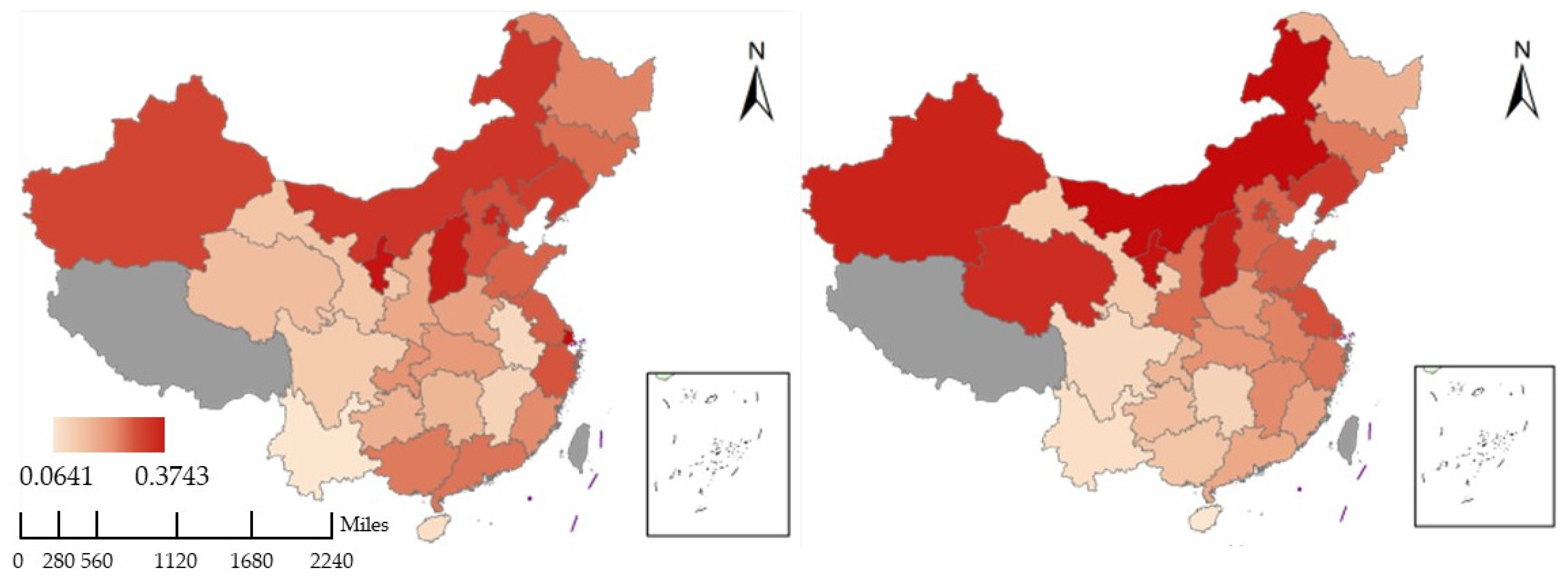
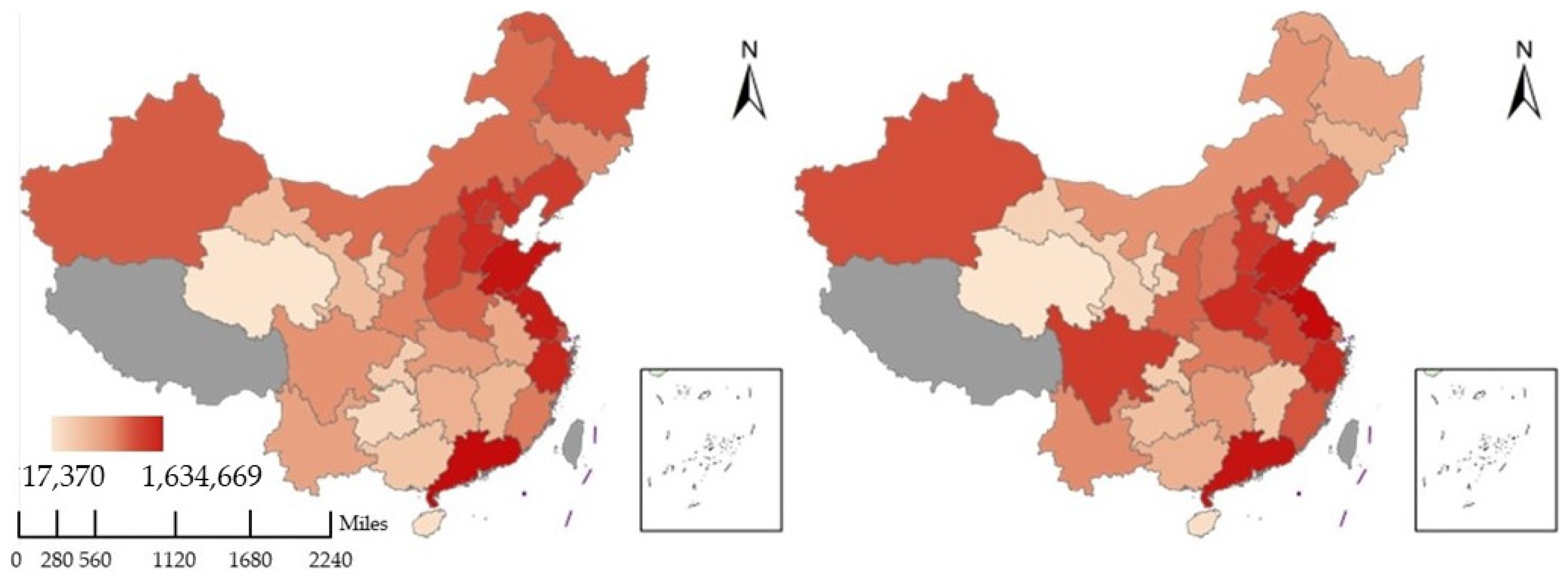
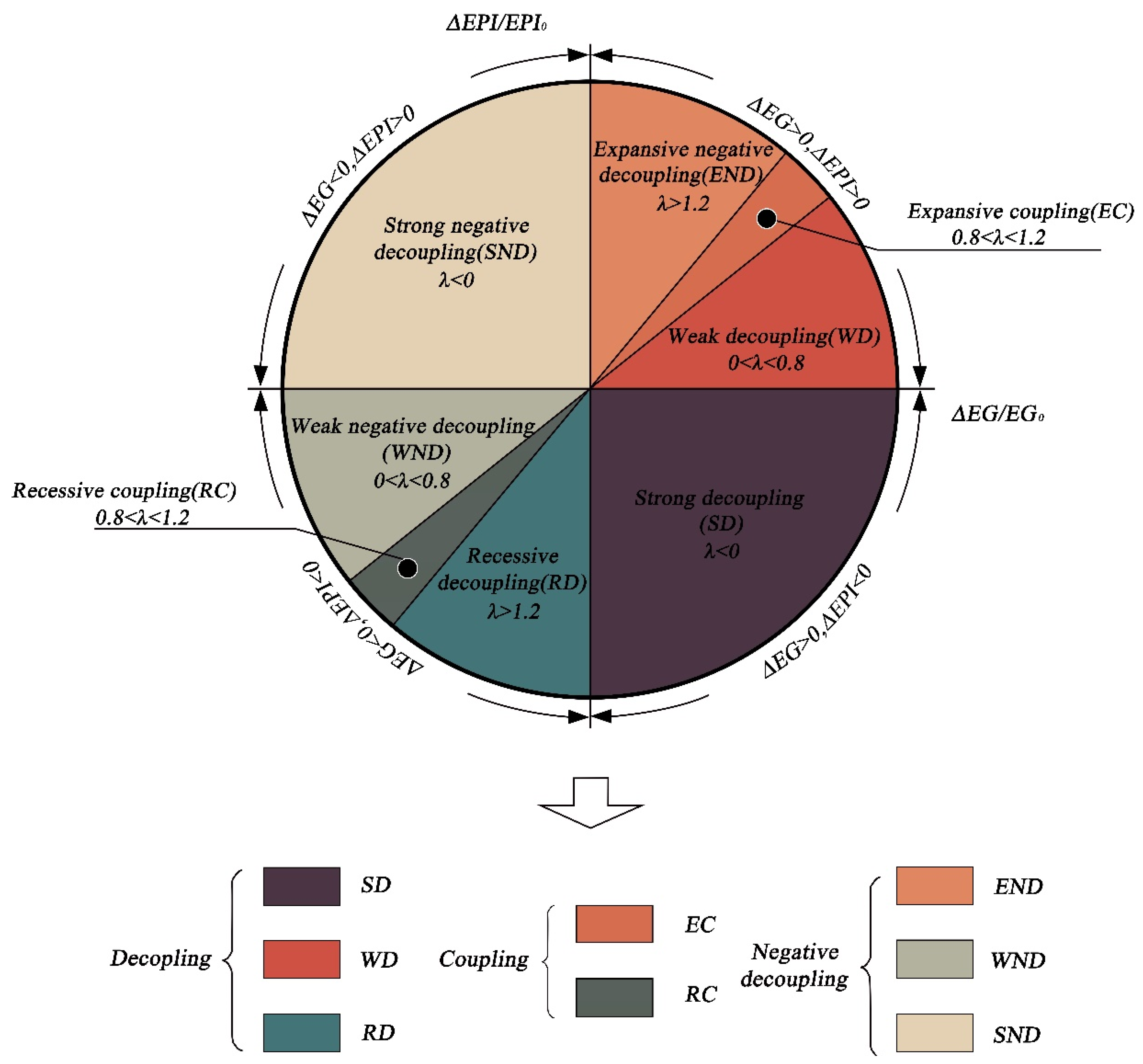

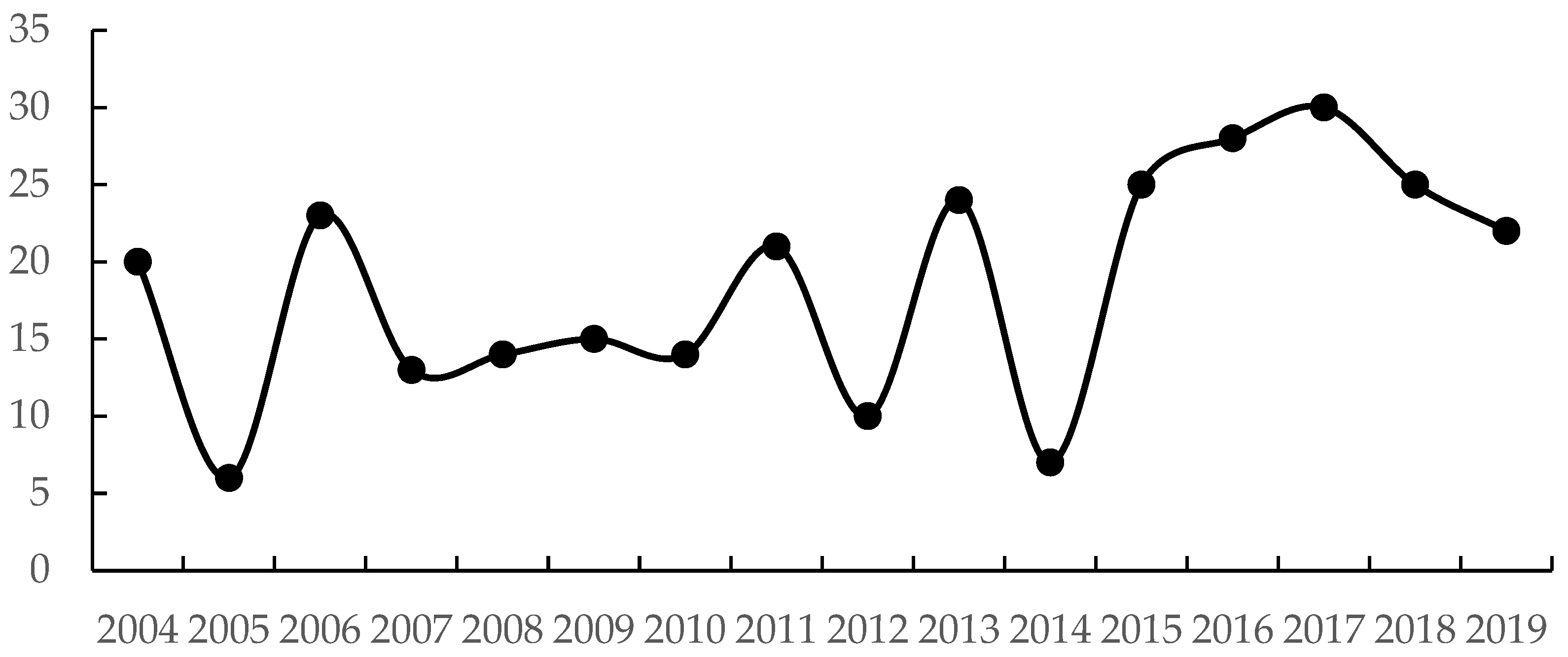


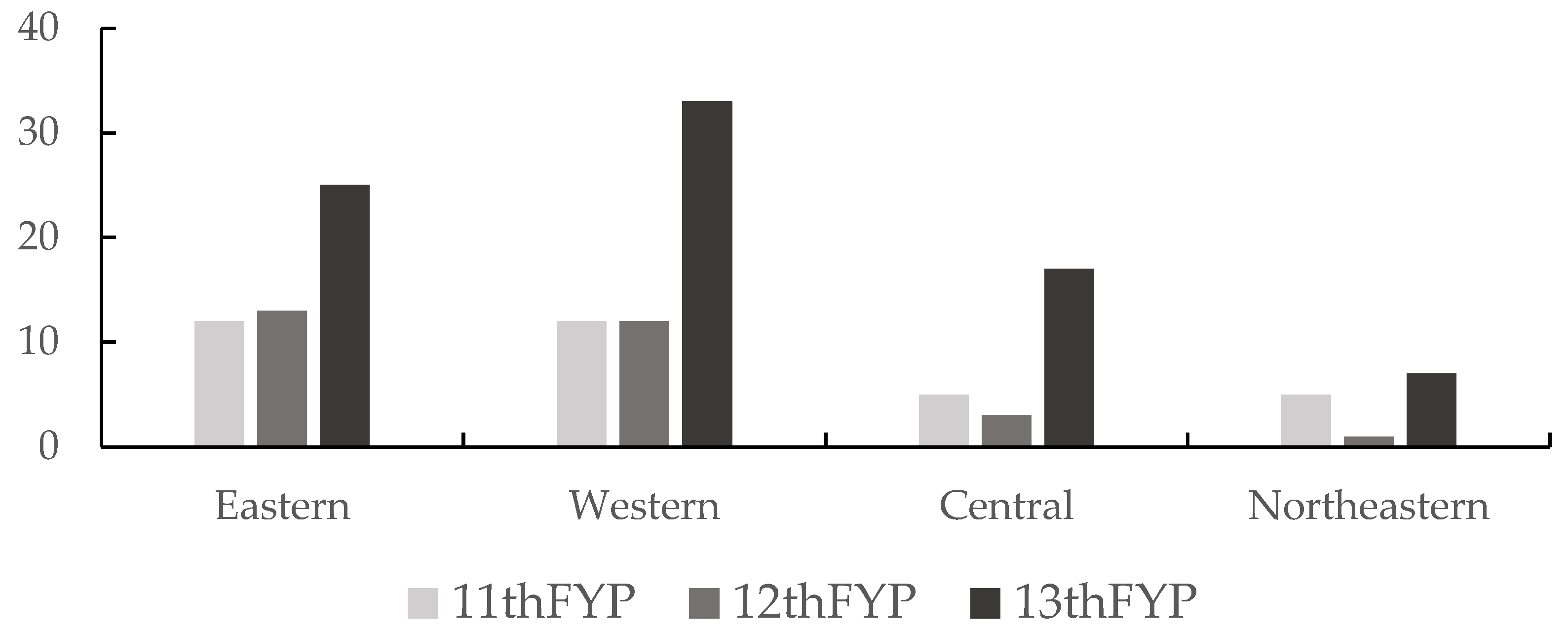

| No. | Relationships between Environment and Economy | Authors |
|---|---|---|
| 1 | Inverted-U shape (EKC hypothesis in long-term) | Grossman and Krueger [33], Hao and Liu et al. [43], Zhu et al. [39], AL-Mulali et al. [44] |
| Inverted-U shape (EKC hypothesis in short-term) | Khalid Ahmed and Wei Long [31], Zhao et al. [34] | |
| 2 | Rejection of the EKC hypothesis | Hettige et al. [45], Ozturk and Al-Mulali [46], Perman and Stern [47], Wang et al. [48] |
| 3 | A monotonic relationship | Stern and Common [49], Azomahou et al. [50], Jaunky [51] |
| 4 | N-shaped | Yan-Qing Kang et al. [35], Yoonseok Lee et al. [36], Hannes Egli and Thomas M. Steger [37], O. Zaim and F. Taskin [38], Zhu et al. [39] |
| 5 | Special relationships (linear positive relationship at the stage of low income and then plateaus) | Bertinelli and Strobl [52], Ahmed et al. [53] |
| 6 | U-shaped | Lopez and Litra [32] |
| First-Level Indicator | Secondary Indicator | Description | Units |
|---|---|---|---|
| Air quality | PM2.5 concentration | Annual average of PM2.5 concentration | Μg/m3 |
| Greenhouse gas | Carbon dioxide emissions | CO2 emissions per capita | Ton |
| Waste gas | Sulfur dioxide emissions | SO2 emissions per capita | Ton |
| Nitrogen oxide emissions | NOx emissions per capita | Ton | |
| Smoke and dust emissions | Smoke and dust emissions per capita | Ton | |
| Wastewater | Industrial wastewater discharge | Industrial wastewater discharge per capita | Ton |
| Chemical oxygen demand (COD) | Chemical oxygen demand per capita | Ton | |
| Solid waste | Hazardous waste | Hazardous waste generation per capita | Ton |
| General industrial solid waste | General industrial solid waste generation per capita | Ton | |
| Environmental Monetization | Regional environmental infrastructure development investment | Regional environmental infrastructure construction investment per capita | CNY |
| Regional industrial pollution control completed investment | Per capita regional industrial pollution control completed investment | CNY |
| Province | 2004 | 2007 | 2010 | 2013 | 2016 | 2019 |
|---|---|---|---|---|---|---|
| Anhui | 85,063 | 130,330 | 133,212 | 398,374 | 441,794 | 666,974 |
| Beijing | 241,992 | 341,549 | 292,066 | 293,819 | 346,528 | 426,005 |
| Fujian | 126,262 | 139,552 | 120,968 | 413,085 | 423,163 | 595,036 |
| Gansu | 66,047 | 66,173 | 90,882 | 150,642 | 167,993 | 217,499 |
| Guangdong | 847,102 | 793,558 | 521,234 | 107,9492 | 105,2835 | 145,5367 |
| Guangxi | 60,822 | 63,545 | 54,758 | 206,772 | 251,557 | 324,731 |
| Guizhou | 30,686 | 26,106 | 26,498 | 184,091 | 245,172 | 294,047 |
| Hainan | 23,425 | 17,828 | 25,575 | 75,458 | 86,228 | 107,918 |
| Hebei | 258,737 | 298,117 | 311,181 | 448,416 | 494,570 | 738,914 |
| Henan | 167,072 | 218,124 | 205,669 | 454,382 | 487,109 | 790,192 |
| 2004 | 2005 | 2006 | 2007 | 2008 | 2009 | 2010 | 2011 | |
|---|---|---|---|---|---|---|---|---|
| ∆EPI | 0.2631 | −0.2030 | 0.0945 | −0.0199 | −0.0974 | 0.0841 | −0.0885 | 0.0024 |
| ∆EG | −0.0297 | 0.3892 | 0.0909 | −0.0687 | −0.022 | −0.0665 | −0.0623 | 0.3566 |
| −8.83 | −0.52 | 1.04 | 0.29 | 4.24 | −1.26 | 1.42 | 0.01 | |
| 2012 | 2013 | 2014 | 2015 | 2016 | 2017 | 2018 | 2019 | |
| ∆EPI | 0.0828 | 0.0871 | 0.1192 | −0.1405 | 0.1792 | −0.0460 | −0.1877 | 0.1086 |
| ∆EG | −0.0865 | −0.1881 | 0.0295 | 0.0186 | 0.1245 | 0.0408 | 0.0273 | 0.1496 |
| −0.96 | −0.46 | 4.03 | −7.53 | 1.44 | −1.13 | −6.87 | 0.73 |
| Year | C | D | ND |
|---|---|---|---|
| 2004 | 2 | 20 | 8 |
| 2005 | 3 | 6 | 21 |
| 2006 | 2 | 23 | 5 |
| 2007 | 1 | 13 | 16 |
| 2008 | 2 | 14 | 14 |
| 2009 | 1 | 15 | 14 |
| 2010 | 0 | 14 | 16 |
| 2011 | 3 | 21 | 6 |
| 2012 | 2 | 10 | 18 |
| 2013 | 0 | 24 | 6 |
| 2014 | 2 | 7 | 21 |
| 2015 | 1 | 25 | 4 |
| 2016 | 0 | 28 | 2 |
| 2017 | 0 | 30 | 0 |
| 2018 | 2 | 25 | 3 |
| 2019 | 3 | 22 | 5 |
| Eastern | Western | Central | Northeastern | |||||||||
|---|---|---|---|---|---|---|---|---|---|---|---|---|
| C | D | ND | C | D | ND | C | D | ND | C | D | ND | |
| 11th FYP | 1 | 24 | 26 | 2 | 30 | 21 | 1 | 17 | 13 | 1 | 9 | 5 |
| 12th FYP | 1 | 28 | 16 | 6 | 31 | 17 | 1 | 20 | 15 | 0 | 7 | 8 |
| 13th FYP | 0 | 31 | 6 | 2 | 40 | 1 | 3 | 24 | 1 | 0 | 10 | 2 |
| Name | Governing Agencies | |
|---|---|---|
| Program 1 | Carbon neutral and carbon peaking strategy | State Council |
| Program 2 | Agricultural and Rural Pollution Control Action Plan | Ministry of Ecology and Environment Ministry of Agriculture and Rural Affairs |
| Program 3 | The Three-year Action Plan of the Blue-Sky Defense War | Ministry of Ecology and Environment |
| Program 4 | Soil Pollution Prevention and Control Action Plan | Ministry of Ecology and Environment |
| Program 5 | Water Pollution Control Action Plan | Ministry of Ecology and Environment |
| Program 6 | Arable Land Quality Protection and Enhancement Project | Ministry of Agriculture and Rural Affairs |
| Program 7 | Air Pollution Control Action Plan | Ministry of Ecology and Environment |
| Program 8 | Grassland Ecological protection subsidy incentive projects | Ministry of Agriculture and Rural Affairs and Rural Affairs Ministry of Finance |
| Program 9 | Beijing-Tianjin Sandstorm Source Control Project | National Forestry and Grassland Administration |
| Program 10 | Central Financial Forest Ecological Benefit Compensation Fund Project | National Forestry and Grassland Administration Ministry of Finance |
| Program 11 | Reforestation Project | National Forestry and Grassland Administration |
| Program 12 | Natural Forest Protection Project | National Forestry and Grassland Administration |
Publisher’s Note: MDPI stays neutral with regard to jurisdictional claims in published maps and institutional affiliations. |
© 2022 by the authors. Licensee MDPI, Basel, Switzerland. This article is an open access article distributed under the terms and conditions of the Creative Commons Attribution (CC BY) license (https://creativecommons.org/licenses/by/4.0/).
Share and Cite
Yang, Z.; Gao, W.; Li, J. Can Economic Growth and Environmental Protection Achieve a “Win–Win” Situation? Empirical Evidence from China. Int. J. Environ. Res. Public Health 2022, 19, 9851. https://doi.org/10.3390/ijerph19169851
Yang Z, Gao W, Li J. Can Economic Growth and Environmental Protection Achieve a “Win–Win” Situation? Empirical Evidence from China. International Journal of Environmental Research and Public Health. 2022; 19(16):9851. https://doi.org/10.3390/ijerph19169851
Chicago/Turabian StyleYang, Zhen, Weijun Gao, and Jiawei Li. 2022. "Can Economic Growth and Environmental Protection Achieve a “Win–Win” Situation? Empirical Evidence from China" International Journal of Environmental Research and Public Health 19, no. 16: 9851. https://doi.org/10.3390/ijerph19169851






